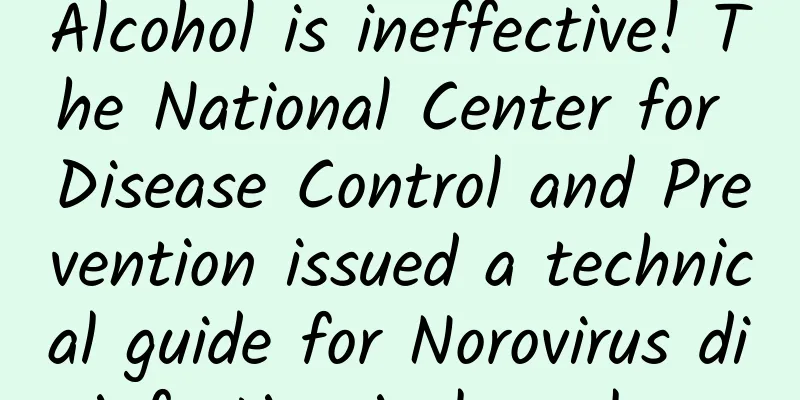Alcohol is ineffective! The National Center for Disease Control and Prevention issued a technical guide for Norovirus disinfection in key places

|
On November 30, the National Center for Disease Control and Prevention issued the "Technical Guidelines for the Prevention, Control and Disinfection of Norovirus Infection in Key Places such as Schools". During the epidemic of Norovirus infection, key places such as schools, childcare institutions and nursing homes should take preventive measures and use appropriate disinfectants regularly for preventive disinfection. Norovirus is most prevalent in the autumn and winter. It is highly contagious, has a short immune protection period, and the entire population is generally susceptible. Norovirus infectious diarrhea outbreaks are prone to occur in places where people gather, such as schools, childcare institutions, and nursing homes. The guidelines are intended to guide key places such as schools, childcare institutions and nursing homes to carry out preventive disinfection during the epidemic of norovirus infection. The guidelines clearly state that when patients infected with norovirus are found in key places such as schools, they should be isolated in time and disinfection measures should be taken as soon as possible. When a patient vomits in crowded places such as classrooms or dormitories, other people should be immediately guided to move to a relatively clean direction and the vomit should be disinfected; at the same time, the environment and supplies contaminated by vomit should also be disinfected. The guidelines suggest that during the epidemic of norovirus infection, key places should take preventive measures and regularly use chlorine-containing disinfectants or other suitable disinfectants for preventive disinfection. If any employee or student has symptoms such as vomiting, diarrhea, abdominal pain, etc., they must not go to work or attend classes while sick, and must go to the hospital for medical treatment if necessary. In addition, the guidelines introduce disinfection methods related to norovirus. This virus is highly resistant to commonly used disinfectants, and alcohol is ineffective against it. High-level disinfectants or effective physical disinfection methods should be used. For large amounts of pollutants such as vomitus and excrement of patients, disinfectant powder or bleaching powder containing absorbent ingredients should be used to completely cover them, or disinfectant dry towels that can achieve high-level disinfection should be used to completely cover them. After disinfection for the action time, carefully clean them . For small amounts of pollutants, disposable absorbent materials can be dipped in chlorine-containing disinfectants with an effective chlorine content of 5,000 to 10,000 mg/L, completely covered, and allowed to act for more than 30 minutes, and carefully cleaned. Avoid contact with pollutants during the cleaning process. Planning and production Source: Beijing Daily Client Editor: Wang Mengru Proofread by Xu Lailinlin |
<<: Academician Chen Jiansheng: Decoding the Universe: The Golden Age of Space Surveys is Coming
Recommend
Lock the CPU frequency of Android devices
[[184787]] This article introduces the method of ...
Analysis of the hot search traffic of public accounts
In recent months, the gameplay based on WeChat se...
How does rice learn to avoid water? A serious rice lover tells you the real reason why the taste of northern and southern rice is different
How does rice grown in water breathe? Rice can gr...
Can metal phones save Samsung?
Editor’s Note: I think Samsung is forced to launc...
Mini Program Optimization Suggestions
Currently, the mini program optimization suggesti...
In "Nezha 2", Ao Bing defeated Shen Gongbao's father with this "cold" knowledge! Cultivating immortals also requires science!
In "Nezha: The Devil Boy Conquers the Dragon...
What should I do if I can’t write good short video copy? How to write short video copy?
After the rise of short videos , whether it is fo...
Fu Lei, "Organizational Methodology: How do organizations undertake strategic changes? 》
Fu Lei's "Organizational Methodology: Ho...
Why do the comments on Weibo and Toutiao for the same news have two different styles?
When browsing Weibo, you will often find that the...
8.15 Japan surrenders! A comprehensive review of the Anti-Japanese War
The above content is excerpted from: "Comic ...
Which super TV is the best? Konka leads to a debate on the current development model of smart TVs
The already established Chinese TV industry has e...
The secret before the shit! This time we opened a box of 38 million-year-old poops
The Earth has existed for 4.6 billion years, and ...
New energy and overseas sales have grown steadily. Self-owned brands account for more than 60% of sales. In April, SAIC Group sold 360,000 vehicles.
(May 10, 2024, Shanghai) Today, SAIC Motor releas...
What are WeChat Mall, WeChat Mini Program, and WeChat Store? What are the differences?
Tencent has many products. Take the "WeChat A...
How to explain sleeping in using physics?
It's really not my problem that I always want...









